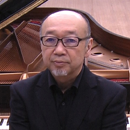Bach-Godowsky: Cello Suite No.2 (arr. for Piano)

Michael Nanasakov
October 25, 2020Bach-Godowsky: Cello Suite No.2 (arr. for Piano)
無伴奏チェロ組曲第2番 二短調
「前奏曲」
非常に思索的、哲学的な音楽で、バッハの内省的な音の流れにゴドフスキーは豊かな対位法的処理を加え、実に深みのあるピアノ曲に仕上げている。曲は原曲にはない低音の二者連打に始まる。
弔鐘のように響く6つの音はこれから展開される3曲の「無伴奏チェロ」の世界を暗示するかのようだ。曲は低音域で沈鬱に始まるが、原曲の5小節目で突如、高音部に「D─C─B 」という息の長いフレーズが加わることで、一挙にその音響世界を広げる。この音の立体感は 実に素晴らしい。この始まりの2ページだけでも鏡像カノンやストレッタ風の動きがあり、ゴドフスキーの対位法の手腕を十分堪能できるだろう。原曲の55小節目以降、バッハの譜面は16分音符のパッセージだけの部分だが、ここでゴドフスキーは主題を再登場させている。
これは音楽の解釈としても正解だろう。そして次第に音量を増し、音域を広げながら、最後にもう一度、分厚い和音で主題が登場するが、ここはバッハの原曲から大きく踏み出したもので(具体的にはチェロ譜の59小節目がピアノの最初の小節に対応する) 圧倒的な終結を作り出している。
「アルマンド」
活気に満ちた軽快な楽章だ。ゴドフスキーは原曲の16分音符にカノン風の動きや対旋律を絡ませるている。
「クーラント」
この曲も16分音符の早い動きに終始する練習曲風の楽章。ゴドフスキーはこの楽章を、力に満ちたピアノ曲に仕上げている。原曲の細かい音の動きが伴奏として扱われ、豊かな旋律との組み合わせが作り出す響きの分厚さは原曲にないものだ。
「サラバンド」
ゆったりとした足取りで悠然と歩を進める穏やかな舞曲。ゴドフスキーはここで、メロディーをオクターブ上げ、低音を増強し、豊かな対旋律を加えることで、重厚な響きを作り出している。さらに原曲20小節目以降を大幅に書き換え、ここに4小節を加え冒頭主題を再現させ、そのまま原曲の21小節目に滑らかに連結させている。また後半に見られる陰影に満ちた半音階和声も魅力的だ。
「メヌエット」
二短調の第1メヌエットと二長調の第2メヌエットからなる雅なメヌエット。
まず第1メヌエット。原曲は前半も後半もリピートで繰り返させているが、ゴドフスキーは前半を単純なリピートにしていない。つまり最初は弦のピチカートを思わせる伴奏を持つ弱音で始まり、次は力強い和音を伴うものとしていて、それぞれ異なった表情が楽しめる。さらに16小節目以降に冒頭主題を再現する4小節を新たに書き加えている。
次に第2メヌエット。ここでも前半は単純なリピートを用いていない。最初は低音で二音を保持音のように使い、2度目では音城を上げ、よりビアニスティックなものとしている。さらに後半原曲の21小節目以降を大胆に変え、8小節を新たに書き加え、第2メヌエットの主部を再現している。
演奏様式的に問題があるとすれば、第2メヌエットの後の第1メヌエットへのダカーポ。 通常なら、ダカーポ以後は「リピート記号」は無視されるのが通例だが、ゴドフスキーの楽譜を忠実になぞれば、「第1メヌエットの前半は緑り返しあり、後半は繰り返しなし」で弾くことになるだろう。どうせなら、ダカーポ以後の第1メヌエットはリピートなしでより簡素なものに新たに書き換えてもよかったのではないだろうか?
「ジーグ」
力と熱に満ちた楽だ。
ここでも対位法的な書法は豊かであり、随所に見られるカノン風の動きなどの工夫が見られる。さらに、原曲の40小節目後半からも大幅に改変し、新たな8小節を書き加え、リピート以後の部分(へ長調になる部分)をもう一度登場させている。そして両手の交差による高音部での主題エコーが加わり、大きく盛り上がり力強く曲を閉じる。
-
english description
Bach-Godowsky: Cello Suite No.2 (arr. for Piano)
"Prelude"
It is very contemplative and philosophical music, and Godowsky adds rich counterpoint treatment to Bach's introspective flow of sound, creating a truly profound piano piece. The piece begins with a bass doublet, which is not present in the original.
The six notes that sound like mourning bells seem to suggest the world of the three "unaccompanied cellos" that are about to unfold. The piece begins somberly in the lower register, but suddenly, in the fifth bar of the original piece, a long, breathy phrase "D─C─B" is added in the treble register, which expands the acoustic world at once. The three-dimensionality of this sound is truly wonderful. In these first two pages alone, there are movements in the style of a mirror-image canon or a stretta, and Godowsky's mastery of counterpoint can be fully appreciated. After the 55th bar of the original, Bach's score has only 16th-note passages, but Godowsky reintroduces the theme here.
This would be a correct interpretation of the music. The theme then gradually increases in volume and range, and finally appears once more with thick chords, but this is a major departure from Bach's original (specifically, bar 59 of the cello score corresponds to the first bar of the piano), creating an overwhelming conclusion.
"Armando."
This movement is lively and light. Godowsky intertwines the 16th notes of the original with canon-like movements and counter-melodies.
"Courant."
This is another exercise-like movement with fast 16th-note movements. Godowsky has made this movement into a piano piece full of power. The fine movements of the original are used as accompaniment, and the combination with the rich melody creates a thick sound that is not found in the original.
"Sarabande."
This is a gentle dance piece in which the player moves with a leisurely gait. Godowsky raises the melody an octave, enhances the bass, and adds a rich counter-melody to create a profound sound. Furthermore, Godowsky rewrites the original piece after the 20th bar, adding four bars to reproduce the opening theme, which is smoothly connected to the 21st bar of the original piece. The chromatic harmony full of shadows in the latter half of the piece is also attractive.
"Menuetto."
This elegant minuet consists of the first minuet in D minor and the second minuet in D major.
First, the first minuet. The original piece has both the first half and the second half repeated, but Godowsky did not make the first half a simple repeat. In other words, the first part begins with weak notes accompanied by string pizzicato, and the second part is accompanied by strong chords, each with a different expression. In addition, after the 16th bar, four bars are newly added to reproduce the opening theme.
Next comes the second minuet. Again, the first half does not use a simple repeat. In the first, he uses two notes in the bass clef as if they were holding notes, and in the second, he raises the pitch castle to make it more Bianistic. Furthermore, he boldly changes the second half of the piece after the 21st bar of the original, adding eight new bars and recreating the main part of the second minuet.
If there is a problem in terms of performance style, it is the dacapo to the first minuet after the second minuet. Normally, after the da capo, "repeat signs" are usually ignored, but if we follow Godowsky's score faithfully, we should play "the first half of the 1st Menuetto with a green return and the second half without repeat". In any case, it would have been better to rewrite the first minuet after Da Capo with a simpler version without repeats, wouldn't it?
"Gigue."
This is music full of power and fervor. Here, too, the counterpoint writing is rich, and the canon-like movements that can be found throughout the piece are ingenious. In addition, the second half of the 40th bar of the original piece has also been significantly altered, with the addition of eight new bars, and the part after the repeat (the part that becomes F major) has appeared once more. Then, the theme echoes in the treble clef by the crossing of the two hands are added, and the piece closes with great excitement and power.
◎ BASE ◎ HMV
JNCD-1008 Track List
Suite No.2 D minor:
Suite No.5 C minor: